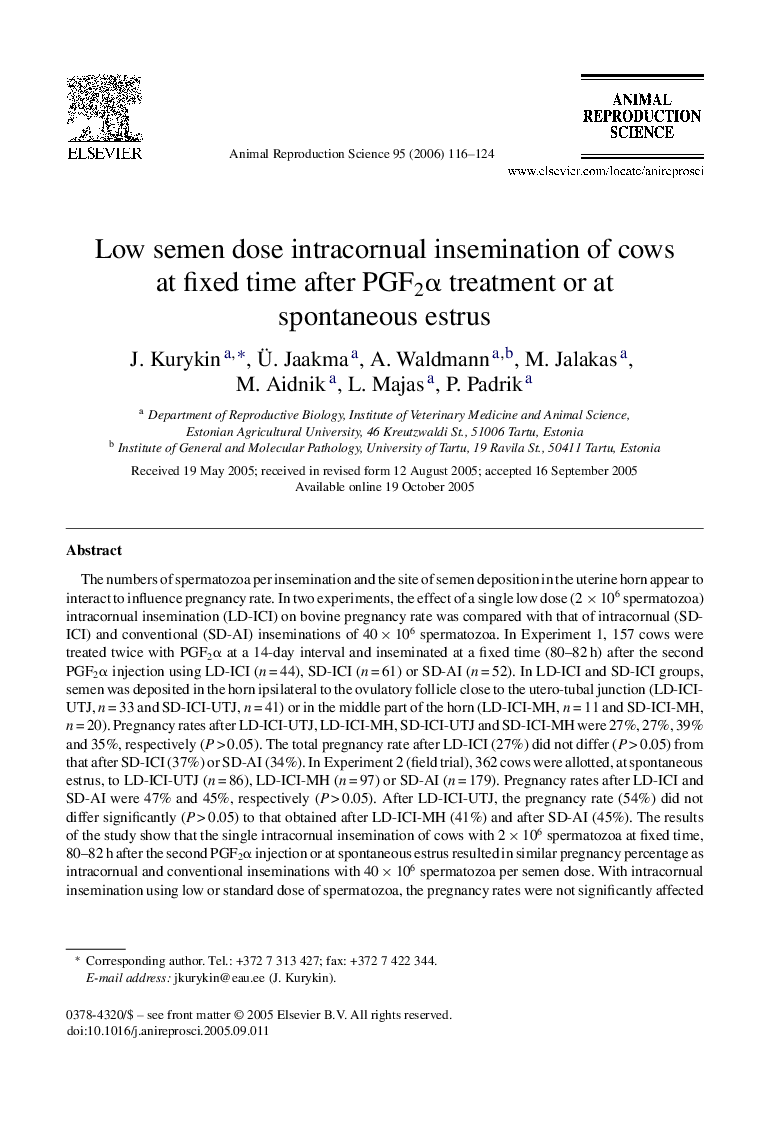| Article ID | Journal | Published Year | Pages | File Type |
|---|---|---|---|---|
| 2074850 | Animal Reproduction Science | 2006 | 9 Pages |
The numbers of spermatozoa per insemination and the site of semen deposition in the uterine horn appear to interact to influence pregnancy rate. In two experiments, the effect of a single low dose (2 × 106 spermatozoa) intracornual insemination (LD-ICI) on bovine pregnancy rate was compared with that of intracornual (SD-ICI) and conventional (SD-AI) inseminations of 40 × 106 spermatozoa. In Experiment 1, 157 cows were treated twice with PGF2α at a 14-day interval and inseminated at a fixed time (80–82 h) after the second PGF2α injection using LD-ICI (n = 44), SD-ICI (n = 61) or SD-AI (n = 52). In LD-ICI and SD-ICI groups, semen was deposited in the horn ipsilateral to the ovulatory follicle close to the utero-tubal junction (LD-ICI-UTJ, n = 33 and SD-ICI-UTJ, n = 41) or in the middle part of the horn (LD-ICI-MH, n = 11 and SD-ICI-MH, n = 20). Pregnancy rates after LD-ICI-UTJ, LD-ICI-MH, SD-ICI-UTJ and SD-ICI-MH were 27%, 27%, 39% and 35%, respectively (P > 0.05). The total pregnancy rate after LD-ICI (27%) did not differ (P > 0.05) from that after SD-ICI (37%) or SD-AI (34%). In Experiment 2 (field trial), 362 cows were allotted, at spontaneous estrus, to LD-ICI-UTJ (n = 86), LD-ICI-MH (n = 97) or SD-AI (n = 179). Pregnancy rates after LD-ICI and SD-AI were 47% and 45%, respectively (P > 0.05). After LD-ICI-UTJ, the pregnancy rate (54%) did not differ significantly (P > 0.05) to that obtained after LD-ICI-MH (41%) and after SD-AI (45%). The results of the study show that the single intracornual insemination of cows with 2 × 106 spermatozoa at fixed time, 80–82 h after the second PGF2α injection or at spontaneous estrus resulted in similar pregnancy percentage as intracornual and conventional inseminations with 40 × 106 spermatozoa per semen dose. With intracornual insemination using low or standard dose of spermatozoa, the pregnancy rates were not significantly affected by the exact site of semen deposition in the uterine horn, near the utero-tubal junction or in the middle part.
